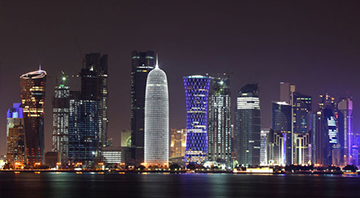

Qatar is one of the safest places in the world. Both visitors and residents have the opportunity to experience the welcoming and friendly nature of Arab culture. Like anywhere else, respecting local traditions and practices allows you to enjoy the true essence of the host country, giving you a better travel experience.
The shining jewel of Qatar, Doha is a multicultural city, home to most of the country's population as well as expatriate communities from a range of origins. Shopping abounds in the city's plentiful malls, while the Corniche impresses visitors with picturesque architecture and dazzling views of the harbor. Doha boasts myriad cultural facilities, including the futuristic Education City and the National Museum. Having hosted the 2006 Asian Games, the city is home to many sports complexes as well.
Qatar has established itself as one of the region’s cultural capitals, hosting major international events. Qatar is also home to the finest cultural landmarks, some even dating back to thousands of years demonstrating the nation’s rich history and culture. In addition, Qatar has a series of world-class museums that house some of the world’s finest art collections.
With the sun shining every day and a surprisingly rich ecology, Qatar offers an engaging natural environment to explore. The surrounding desert provides a great deal of interest and adventure with such natural landmarks as the Dhal Al Misfir, Desert Roses and the Singing Sand Dunes.
Museum of Islamic Art: The stunning Museum of Islamic Art, designed by I.M. Pei, famed for his modern wing of the Louvre in Paris, is an icon for art, culture and heritage, housing precious works from more than 200 years of Islamic civilization.
Mathaf Museum: The Mathaf Museum of Modern Arab Art opened in Education City in 2010 and hosts regular exhibitions of contemporary art with a permanent collection of regional art and design.
Katara Cultural Village: Katara Cultural Village is the focal point for arts and culture in Doha and has art galleries, an amphitheater for opera, drama and concerts performance as well as restaurants and a beach and water sports facilities.
Fort Zubarah: A trip to the ancient 18th century Fort Zubarah in the North of the country is a must for visitors wanting to explore Qatar’s historical landmarks.
Souq Waqif: Souq Waqif offers the bustle and vitality of old traditional souq with perfectly replicated buildings featuring traditional architecture. There you will find handicrafts on display as well as traditional foods and spices, perfumes, fabrics and art. Young Qataris are being encouraged to set up businesses promoting old crafts and traditional wares.
Sheikh Faisal bin Qassim Al Thani Museum: Sheikh Faisal bin Qassim Al Thani has built his own museum at his farm in Al Sheehaniya located 20km west of Doha. This private museum comprises of more than 15,000 pieces, collected during his worldwide travels. The museum has a varied collection of artifacts including fossils, manuscripts, textiles, weapons, ceramics, woodwork, contemporary art, pre- and Islamic coins and foreign currency.

Climate:
The best time to visit Qatar is between October and April, when the temperature dips. The coolest months are December, January and February.
The high temperatures (touching 50°C in July-August) coupled with a 90% humidity restricts outdoor activities during summer, but there is still plenty to do within many of Qatar’s well-fitted indoor facilities.
Language:
Arabic is the official and main language, but English is widely spoken in every part of the country. Despite the fact that most Qatari people speak fluently English.
Currency:
The monetary unit is the Qatari Dinar.
Clothing:
Men and women should dress modestly as a courtesy to both Qataris and Muslims. Swimsuits and beachwear are acceptable at the hotel beaches (don’t forget sunscreen), but it is not appropriate to show too much skin in other public areas. Tops should cover the shoulders and upper arms, and skirts or shorts should fall to or below the knee. Women are not obliged to cover their hair. Visitors should be thoughtful of their clothing particularly in the Holy Month of Ramadan.